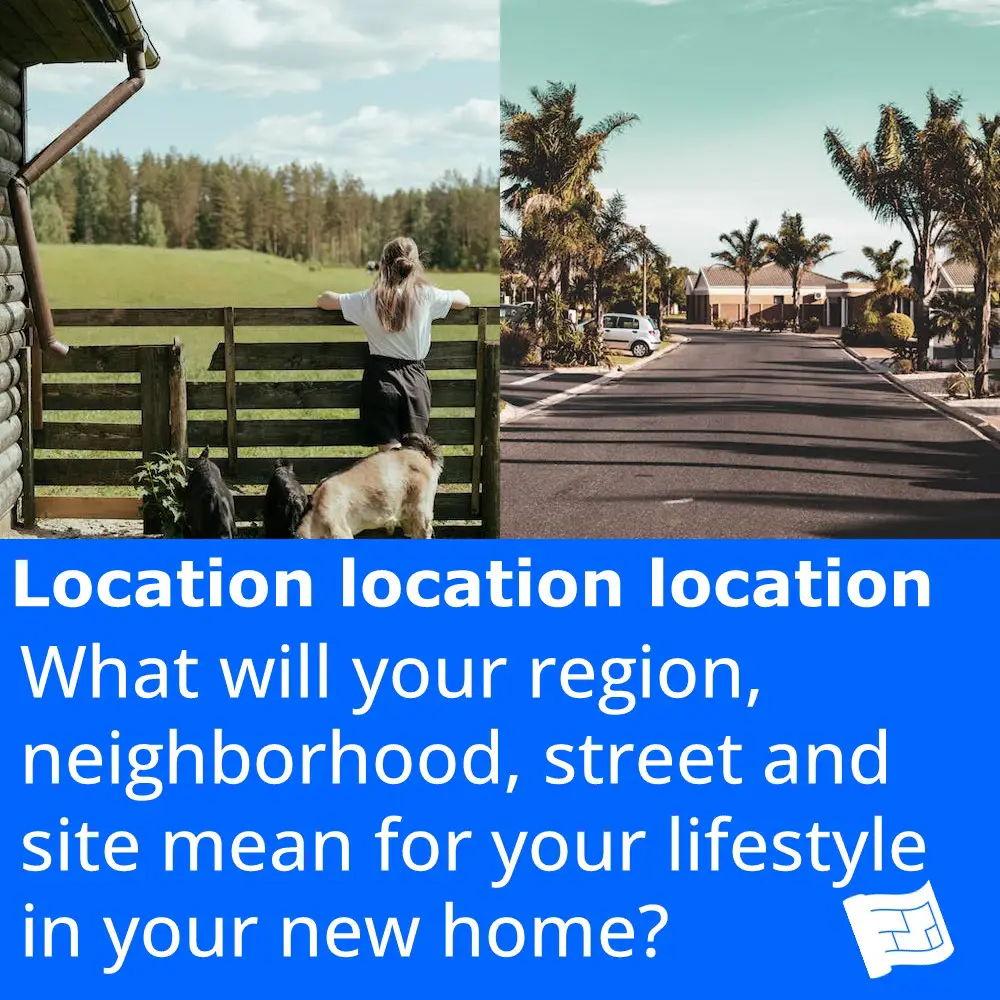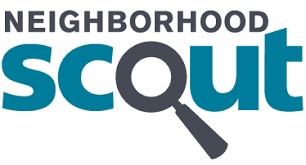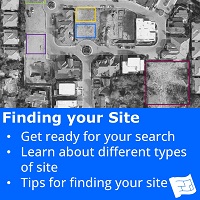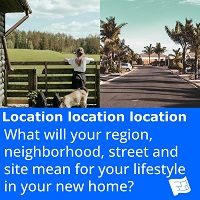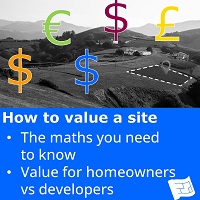- Home
- Your Lot ¦ Plot ¦ Site
- Finding Your Site
- Location location location
Location location location
We’ve all heard the saying – location, location, location. The location of your site determines a great deal about your lifestyle, influencing things such as the setting of your home, who your neighbors will be, the climate, the schools, work opportunities and amenities available, and how easy it is to get about to the places you need to go.
If you're free to choose your location, then the lifestyle that you're looking for will dictate what you want from your location.
This topic is all about imagining in detail what it would be like to live in the location that you're considering.
Even if you've already found your site, I encourage you to read on to discover insights and tools that will give you more information about your location.
I find it helps to take the approach to consider your location at different levels of 'zoom' (if you imagine a Google map).
- Your country and region
- Your neighborhood
- Your site (there's lot's of site specific information once you've zoomed all the way in to your site)
For each of the topics covered on this page, think about them at those three levels in turn.
So let's look a bit more into what is determined by your site's
neighborhood so that you can have an in-depth think.
- The climate ☀️ 🌧️ ❄️
- The environment you'll be living in (rural, suburban or urban) 🏞️ 🏘️ 🌇
- The amenities and facilities available to you (places and spaces) 🏢 🏫
- Transport options (getting around) 🚗 🚌 🚉 🚇 🚋 🚲 🚶🏽♀️ 🚶🏾
- Opportunities for nature 🏕️ 🏖️ 🚵 🏂 🏄
- Safety 🦹 🔪 🔫
- Architecture 🏠
And all this has an impact on the price you'll pay 💵 💷 💶 when you actually find your site.
I think you'll also enjoy 'How to create curb appeal' which discusses the context of your site in your neighborhood.
Climate
Your regional location dictates the climate and the amount of sunlight that your home will receive each day. Both of these will play a large part in your home design and consequently your lifestyle both inside and outside your home.
Environment - Rural, suburban or urban?
Have you decided on the type of area and surroundings you want to live
in? Are you looking to live in a rural, suburban or urban
environment?
Most homeowners have quite fixed ideas about the type of locale
they’re looking for.
You might be surprised at what's possible if you adopt a more flexible approach to your location. Think about your lifestyle needs and then consider how different types of location could serve (or hinder) those needs. Work in terms of what you need from a location for your lifestyle before narrowing down your search too much.
For example…

Location temptation...
Let's say you are a family with school age kids and you and your partner have jobs in the city that require you to attend the office 3 days a week. The suburbs are often a popular choice for this scenario but are there other possibilities?
- How would this compare with a site in an urban location with good schools and your office within walking or cycling distance? Now, how about if there was an apartment available with a generous roof terrace and a large park on the same block?
- Compare the suburbs with a close-knit rural community with essential services at the center of your village and great transport links into a large town or city. Let's throw in the fact that there's a school bus that services the village where you're looking at finding your site.
The type of locale you choose can have a large impact on the amount you'll pay for your land or property so it can pay to consider all the possibilities carefully.
If there's a neighborhood that you like and you'd like to explore other neighborhoods that might be similar, then try the match function at Neighborhood Scout.
Places and spaces
Your life is made up of lots of places and spaces where the activities of your life take place. You need to get to work or school, buy groceries, run errands, pick up the kids, visit your family, the list goes on. With a little care during the process of finding your site to select your site location well, you can do all of these things with a little more dignity, a little more comfort and, dare I say, even a little bit of pleasure.
Key places
Key places are the places that we use regularly (daily or weekly) for necessities and fun. Examples of these might be…
- Your place of work
- Where your kids go to day care or school
- Your nearest shops
- Where the activities your enjoy take place (eg park, gym, tennis club etc)
- Your place of worship
- etc - everyone will have their own list.
Think about what your key places are, the ones you use on a daily or weekly basis and how you want to experience getting about in your daily life.
Then there are places that we use less often but still want to be able to get to them conveniently. Examples of these places might be.
- Pharmacy
- Doctor’s office
- Vet
- Gas station
Everyone has different lifestyles and different places that they
need to get to and different ways that they want to do it. Read more on getting around.

A day in the life...
I've lived in a number of different places. Here's an example of different locations and how they relate to my key places.
One place I lived was in the suburbs and my work was slightly more out of town in an office park. I used to drive my toddler to the day care, then drive a short distance to park the car in a pretty expensive parking lot near the public transit line and catch the public transit to the office. Driving to the office took way longer. At the office park there weren't many amenities. Lunch options were limited and I'd need a car (which I'd left in the transit lot) to do any errands during lunch.
Then at the end of the working day I did the same journey in reverse to pick up my toddler and get home.
I now live where my work is a 20 minute easy bike ride from my home. The kids' school (old enough to ride bikes at this point) is also close and they can take themselves to and from school. I have a huge choice for lunch and I can easily pop out to do errands anywhere in the city center because I have my bike and can ride and 'park' anywhere quickly. There's a grocery store and other shops on my route home so the perceived effort of stopping off to pick up a few groceries or whatever on the way home is low (again easy on the bike). I also get to enjoy the health and financial benefits of riding a bike in order to get around.
No prizes for guessing which location I preferred 😉.
Third spaces
Third spaces is a thought that came to me one day, so I just wanted to include it hear as it's very much to do with the places and spaces available around your home.....
We spend a lot of time at home (first space). Then there's home or school (second space). Then there’s all the other spaces where we can spend time. I call these third spaces.
If third space are spaces outside our homes, how can they possibly be anything to do with our home design? We’ve already talked about how your location will influence your lifestyle, so it seems to me that it makes sense to include all the spaces where we spend our lives when we’re designing our lifestyle in terms of our location.
Let’s have a look at some examples of third spaces and how we use them.
- The local coffee shop for a drink made for you and a chat with a friend, or reading, or maybe working
- The local restaurant for a meal
- The local pool for a
swim and spa if you're lucky
- The park or countryside for some renewal in the outdoors
- The playground for the kids to play
- The local hotel to put your overnight guests up
- The beauty salon for a chat and 'me time'
- The gym for a workout
- The hotel lobby for some people watching and maybe doing a bit of work
- The tennis club / sports club / country club
- Your favorite night spot
- The library for a quiet read
- The cinema
- The theater

Lifestyles of the rich and famous
When I was writing that list something struck me. Take a look at how many things on that list might feature on the real estate listing of a mansion fit for the rich and famous.
If you had all the money in the world you might request a pool, a tennis court, a home cinema and a home gym to be included in your house plans. And perhaps you’d have a private chef to serve you a meal or make you a cup of coffee.
So, if you have good third spaces available nearby, you can live like a millionaire, and you can choose which ones you use and when, and you don’t have to pay to build or maintain them – Happy days.
Getting around
Real estate listings for the area that you're interested in will often say things like 'excellent transport links'. Don't take them at their word. It can pay great dividends to research transport options (and everything about them) in depth before you make the decision on any particular location, neighborhood or site.
Occasional travel
We all need to get places every day but it's also important to consider the more occasional travel we do such as vacations and weekend trips.
How well connected is the region you're considering. Is there an airport, train station and freeway? Where can you get to using planes, trains and automobiles? Take a look at the destinations available.
Daily travel
To imagine what your daily travel would be like here are the steps I suggest taking to get really acquainted with the transport options in the location you're considering. I've used this process many times when considering different places to live in the different cities I've lived in.
- Take a screen shot of a google map of the overall area in which you want to find your site, or print one out.
- Then mark on it the key places and third spaces you see you and your family using. Do you notice anything about how they relate to each other? For example, passing nearby a grocery store, or past the day care or school on the way to work
is golden.
- Now it's time to learn about the transport in your location. Don't look only at the mode of transport that you're most used to. If you take time to explore all the alternatives you might be surprised at the possibilities that reveal themselves.

A transport option anecdote...
When the terror attacks hit London in July 2005, many people had to take an alternative route or method of getting home. And you know what? Some people didn’t go back to their usual route because they found something better.
Personally I discovered that I could walk home in about 90 minutes and the walk took me through some nice parts of London including a park and crossing the river. It was a very pleasant walk. It wasn't something I could do every day, but I did take to walking home on the occasional sunny summer evening. I'd never have considered it if I hadn't been forced into it.
So be sure to explore all the opportunities for getting from A to B.
Roads
First take a look at the road system. The tendency when considering locations is to just look at the distance as the crow flies when it's important to figure out the route you'd actually need to take.
Starting with the biggest type of roads take a look at the freeways and most importantly where the interchanges are, and if the interchange has both an on and off ramp. The distance to a freeway interchange is an important factor in determining how long your car commute might be if you need to use the freeway.
Then familiarize yourself with the main roads. Find out if there are any one way systems at play or any left or right turn restrictions. Again this can have a huge impact on driving time and convenience. Is the capacity of the roads reduced at certain times of day by the use of bus lanes?
Then move on to smaller roads, again noticing one way streets and dead end streets. One way streets are a factor in driving time. Dead end streets obviously mean that it can't be used as a driving route and can be nice quiet streets to live on.
Where are the parking garages and parking lots and how much do they cost?
One of the best things to do is to get our there in your car (or bike) and try out a few routes at different times of the day.
- Do queues of traffic build up on any particular roads?
- Are there some roads which are quiet because they don't form part of a convenient route for most journeys? These can be great streets to live on.
- Are there roads that
are used as rat runs / short cuts? These are good to know if you want to speed up your route but perhaps you'd want to avoid these streets to live on.
- Are there any places that turn into a traffic nightmare at any particular time? Look out for schools and stadiums.
In the absence of driving around yourself, put your most common destination pairings into google maps at different times of day and note down the results in terms of suggested route and journey time.
Asking a local taxi driver is a great way to find out more about local traffic and local routes
if you can't drive around yourself.
Public transport
The main forms of public transport are trains, trams, subways and buses. Don't forget school buses as well. The tendency can be to just look at routes but again, it's worth getting forensic to build up a full picture of your options. Here's what to find out.
- Mark the public transport routes on your map.
- Take a look at the timetables. When do they operate and how long does the journey take? Are there options
that are convenient for when you’ll want to travel? Whereabouts in the journey cycle would you be getting on/off?
Is the bus or train
going to be packed to bursting when it gets to your stop?
- Find out about the fare structures and ticketing options.
- What's the crime and safety record?
- Are there park and ride options?
- Could you combine cycling with public transport?
Google maps can be of great help in investigating public transport options.
You can also take a look at Walkscore to find out about transport options in any particular neighborhood.
Before moving away from public transport consider public car options.
- Is there a car share service available in your location?
- How about taxis? Is it generally easy to get a taxi or are they in short supply? Is Uber widely available?
Cycling
I'm a real fan of cycling. It's cheap, has great health benefits and over shorter distances is often quicker than driving or public transport.
There's a huge tendency to dismiss cycling as unsafe or inconvenient in the rain but for me the benefits far outweigh the risks and any perceived inconvenience. You can find more information on safe cycling at the NHTSA Bicycle saftey section.
I really encourage you to explore cycling as an option.
Here's what to find out about cycling.
- If there are cycling maps available, take a look at them. Again Google Maps is brilliant in cycling mode.
- Where can you lock your bike at your key places?
- Where are the bike shops for when you haven't got it in you to repair that puncture yourself?
- Is there a bike share scheme in your location?
- Would a folding bike widen your options? Could you combine cycling with some other form of transport, or cycle to work and catch transport back at the end of the day when you're tired.
So, get out on your bike and have a cycle round.
- See if you can spot good places for locking your bike.
- Be on the lookout for little pedestrian cut throughs you can also use on a bicycle.
Walking
Walking is free and healthy. Don't forget about Walkscore for a quick method of finding the walkability of a neighborhood. You can also get a really good feel for a neighborhood exploring on Streetview. Remember that nothing beats getting out there are walking around in person.

Getting around example
Let’s have a look at an example…
You can see two locations highlighted with blue boxes in the
image below. Let's say you're finding your site and you're considering them both.
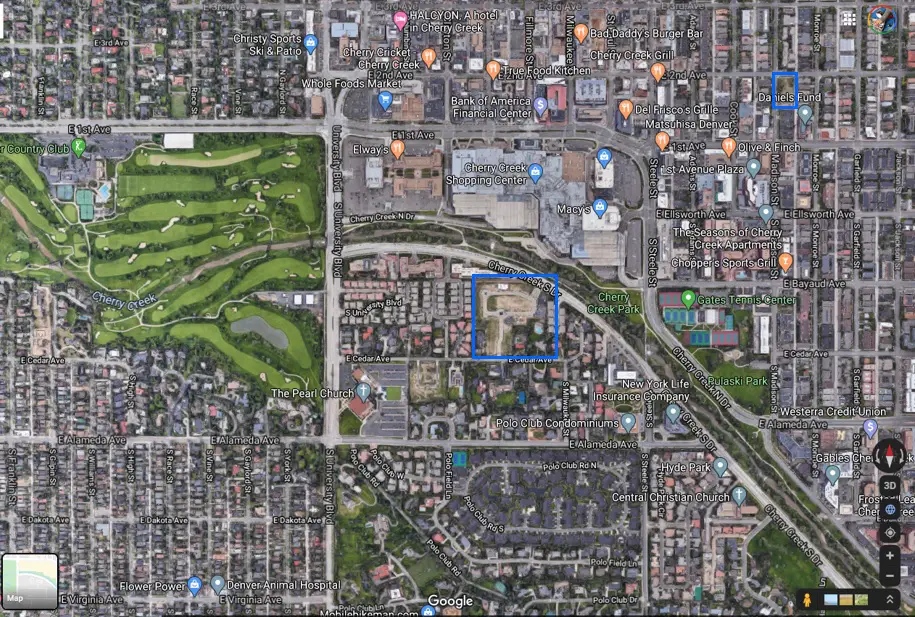
Click here to see this location in google maps
So you can see some of the amenities (and I’m sure there are others that aren’t named on the map)
- Shopping center
- Restaurants
- Cherry Creek Park
- Golf club
- Church
- Tennis center
Now – for each of the locations, think about how exactly you would access the amenities from each of the two locations.
The location off East Cedar Avenue appears to be very close to the shopping center at first glance. Upon closer inspection, the entrance to the shopping center is from East 1st Avenue and South Steele Street. If you’re in a car, you’ll have to drive much further than the crow flies to get to the mall. If you’re on foot, you’ll need to find your away across the creek and make your way into the back of the shopping center.
It's a similar story to access the restaurants.
The location up on East 2nd Avenue, while being more urban in nature, has much easier access to the local amenities that you’re likely to use more often.
I hope that demonstrates how different the accessibility of two sites in the same location can be - and that's just looking at driving and walking.
Bus routes operate North-South on South University Boulevard and East West along East 1st Avenue so both locations are served by a bus route. Depending on your circumstances, one of these bus routes might be more convenient to you that the other which might swing the decision one way or the other.
As well as the amenity considerations, if you take a look at street view you can easily see that the character of each of the locations (and probably the price) will be quite difference. The houses at East Cedar Avanue have been constructed since I took the screen shot above.
Opportunities for nature
Experiencing nature is key for our well-being.
What nature is available in your wider region for a trip at the weekend? Countryside, mountains, forest, desert, ocean, river, lake, prairie?
Is there a variety of landscapes you can immerse yourself in for renewal? What can you do there? Walk, Swim, bike, ski?
Is it easy to get to? How long will it take? How will you get there?
What opportunities does your neighborhood provide for you to come into contact with the natural world as you move about during your day?
What open spaces are available and how much greenery is there in the neighborhood?
Trees and planting
Trees and other planting are really beneficial. Here's why...
Trees change the climate of streets (and whole cities) by providing buildings and street surfaces with shade from the sun and protection from the wind. This makes it more pleasant to spend time outdoors on the sidewalk and easier to move about on foot and bicycle or wait for transit.
Trees act as privacy screens in densely built areas.
They filter strong sunlight, reducing glare and act as light reflectors, throwing a dynamic ‘dancing’ light into buildings. Trees provide a hugely significant sensory experience for people in streets with their sounds, smells and movements.
Their ever-changing appearance gives people an awareness of the seasons and the passing of time, and effectively turn streets into linear parks.
Trees absorb carbon dioxide. Since cities produce most of the carbon dioxide, it makes sense to place trees at the source of the problem and where people are most vulnerable.
Trees are natural air filters, capturing dust and other particles from the air by trapping them on their leaves and in their bark, as well as absorbing unpleasant smells and pollutant gases such as ammonia, sulphur and nitrogen dioxides. This is particularly significant in relation to vehicle emissions.
If you're lucky enough to have trees in your neighborhood don't forget to enjoy them!
Safety
Safety can be a big consideration. Here are some ways that you can find out more about how safe your location might be both in terms of personal safety and security for your home.
Pull up a Google map of your location. Take a look at both the map views and the satellite views and ask yourself some questions…
- How densely are the houses packed? Further spaced out homes means less people with eyes on your property.
- Are there windows onto the street, or are houses set back a long way from the street? If people can see the street easily and your property, then this is like an extra layer of security that you get for free.
- Look at the layout of the roads – are there through roads or cul de sacs? A quiet road is nice, but it’s also easier for people to get up to no good on a quiet road with little traffic passing.
Have a look at street view...
- Are there cars parked on the street?
- Are there sidewalks?
It’s an irony but the wealthier the home-owner, the more of a target their home is, the bigger the house is, the further it is from neighboring properties, the further they’re set back from the street, sometimes behind high hedges and gates, the less intrinsically secure they are because there are no neighborly eyes on them. You’re also likely to have less incidental interaction with your neighbors, just by the fact that you’re further away from them.
Have there been any notable crimes in the neighborhood?
Architecture
Each neighborhood will have it's own character. Do you like the style of the neighborhood? Will you be proud of your new home's curb appeal?
Wrapping up
As I mentioned in the introduction, you were probably already considering all the different elements of your location. I hope that this topic has helped you think in more depth and imagine in detail the pros and cons of a specific location.

